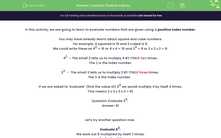In this activity, we are going to learn to evaluate numbers that are given using a positive index number.
You may have already learnt about square and cube numbers.
For example, 4 squared is 16 and 2 cubed is 8.
We could write these as 42 = 16 or 4 x 4 = 16 and 23 = 8 or 2 x 2 x 2 = 8.
42 - The small 2 tells us to multiply 4 BY ITSELF two times.
The 2 is the index number.
23 - The small 3 tells us to multiply 2 BY ITSELF three times.
The 3 is the index number.
If we are asked to "evaluate" (find the value of) 34 we would multiply 3 by itself 4 times.
This means 3 x 3 x 3 x 3 = 81
Question: Evaluate 34.
Answer: 81
Let's try another question now.
Evaluate 53.
We work out 5 multiplied by itself 3 times.
5 x 5 x 5 = 125
Answer 53 = 125
We are now going to work out (-5)3.
We will need to multiply (-5) by itself 3 times and we will need to follow the rules for multiplying negative numbers.
This means we need to calculate: (-5) x (-5) x (-5)
The first step is to find (-5) x (-5)
Two negative numbers multiply to make a positive number, so the answer to this step is +25.
The next step is to multiply this result by (-5).
25 x (-5) = -125
Answer (-5)3 = -125
In this activity, we will evaluate positive and negative indices to work out the whole number value of each and whether the outcome is positive or negative.
You will need to have your scientific calculator handy for some of the questions in this activity.








